A gold and gemstone tiara, richly decorated with plant motifs. A striking and highly elaborate shuttle earring decorated with phytomorphic motifs and winged figures (so-called nikai), all made using the filigree technique. A bizarre nutcracker in the shape of hands, made of bronze with gilded decorations, which would delight many of today’s table decoration enthusiasts. An elegant shrine in the shape of a shell with, in the center of the valance, the figure of a Nereid riding a sea horse. And then again bracelets, necklaces, rings, pendants, seals, jewelry all in excellent condition and in highly sought-after fashions. These are some of the so-called golds of Taranto, the extraordinary collection of goldsmith’s art from the Hellenistic period (thus dating from between the fourth and second centuries B.C.) preserved at the National Archaeological Museum of Taranto (MarTa), which has dedicated a special room (among the museum’s most popular and popular ones) to the golds and from some of the necropolises in the area. At that time, Taranto and its environs were at the center of what today we might identify as a “goldsmithing district”: the production of precious objects was widespread here and the workshops, drawing in all likelihood on sources of inspiration from Greece, handed down the techniques of workmanship from generation to generation (although, unfortunately, we are not left with the names of the artisans who gave rise to such a flourishing and refined production).
It is interesting to point out how, on this production, the link between Taranto and Greece must have exerted a certain influence: one of the main centers of Magna Graecia (the vast area of southern Italy that from the 8th century BC was colonized by the Greeks, who founded numerous cities here and brought their culture), the ancient “Taras” knew precisely in the Hellenistic age its period of maximum development. Allied with the Spartans (in fact, it seems that it was Spartans who were the settlers who founded the city, whose birth is traced back to the conventional and traditional date of 706 B.C.), the Tarantines, in the middle of the fourth century, reached the height of their power and expansion, even coming into conflict with Rome: only in 209 B.C. did the Romans finally get the better of the Tarantines in the context of the Punic Wars (in that year the city was conquered by Quintus Fabius Maximus, who had it sacked and enslaved thousands of Tarantines and their allied Carthaginians), while from the following century the city was finally incorporated into the Roman republic. Throughout this time, Taranto had remained essentially a Greek city: its inhabitants spoke Greek, dressed in the Greek manner, and were of Greek culture. The great dramatist Livy Andronicus, to name the most illustrious of the Tarantines of the time (he lived roughly between 280 and 200 B.C.), was of Greek language and culture, and he assimilated Latin culture only as he was brought to Rome as a slave, as a young boy, following the first occupation of Taranto by the Romans (the name “Livy” refers to the Roman family with whom he served as a slave: he earned his freedom perhaps by virtue of his skills as a tutor).
Goldsmithing in Taranto was closely linked to the city’s dependence on Greek culture, so much so that, following the final subjugation of Taranto by the Romans, goldsmithing entered inexorably into decline until it disappeared in a short time (this was a crisis that went hand in hand with the decline of the city, which under the Romans was no longer able to achieve the cultural and political hegemony that it had managed to gain in the Magna Graecia era). And it was therefore between the 6th and 3rd centuries, thus in the period of the city’s greatest economic development and urban expansion, thatTarentine goldsmithing experienced its highest splendor, the height of its flourishing and refinement, even managing to produce typical objects, which have no counterpart elsewhere: it has been pointed out that diadems in thin gold foil stamped with leaf motifs (which could be oak, laurel, olive, ivy or other plants), for example, are characteristic of Tarentine production. The fact that much of this gold was found in necropolises informs us about the social function of the jewelry, which was not only flaunted in life by its wealthy owners (of course, we have to imagine that because they were works of exceptional refinement, they were items that only a small and fortunate portion of the population of Tarentum could afford: they were still luxury items), but they were also included in their burials, since the condition of the deceased was also to be expressed in their journey to the afterlife (golds thus became a distinctive feature of aristocratic burials). The grave goods, which especially enriched women’s burials, concerned both the deceased who were interred and those who were cremated: the remains of the most prominent figures, whatever the mode of burial, were always accompanied by gold and jewelry. Objects that, as mentioned, had disseminated Greek models to Taranto: in particular, the marked naturalism of the decorations, the chromatic effects achieved through the use of enamels, and the taste for decoration were all related to what, in the same periods, was being produced in Greece (all of which then went on to embellish the repertoires of forms and models typical of the place). Tarentine production was also affected by what was happening in Greece on a purely economic level, since Alexander the Great ’s expansionism eastward in the last decades of the fourth century B.C.E. had enabled the opening of new markets and the importation of large quantities of raw material from the East, which through the trade routes of the time reached Magna Graecia. Most of the gold from Taranto was worked in filigree, a technique found in many of the objects found in local burials: thin threads of gold were applied to the metal surface by soldering, which, interwoven, twisted or juxtaposed, went to make up a refined texture that formed the decoration of the object.
 |
| The National Archaeological Museum in Taranto. Ph. Credit Fabien Bièvre-Perrin |
 |
| Taranto, the columns of the ancient Temple of Poseidon. Ph. Credit |
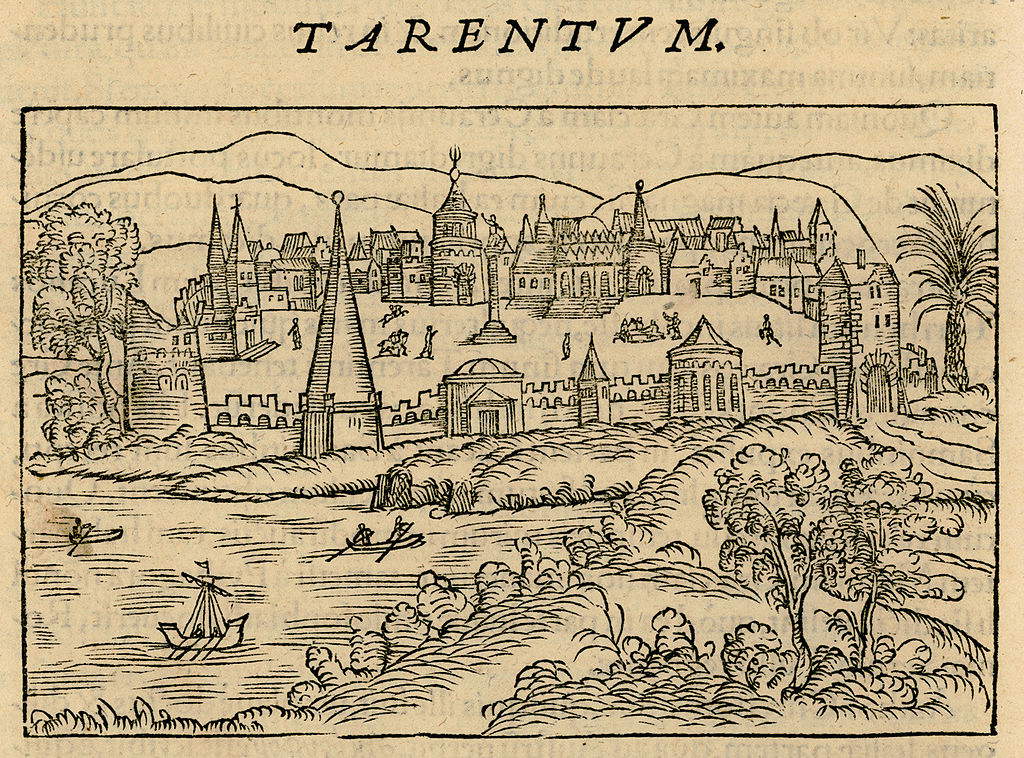 |
| Taranto in an engraving by Nikolaus Gerbel from 1545. |
Among the most valuable golds is the flowering diadem from the “Tomb of the Ori of Canosa,” where it was found in the 1920s: the discovery of the tomb, in the territory of Canosa, occurred by chance in 1928, and the excavation that led to the discovery of the objects was immediately covered over to be all but forgotten until 1991, when the tomb was reopened to allow experts to conduct more in-depth studies of the burial, the objects found there, and their function. The tiara is a piece of work dating from the mid-3rd century B.C., made of gold, pearls, enamel, glass paste and semi-precious stones (or " semiprecious stones": these are mainly carnelian and garnets), which was worn on the head (a hinge allowed its width to be adjusted to fit... different sizes) and then fastened at the nape of the neck by a ribbon. The work is especially striking for its rich decoration (more than a hundred and fifty flowers that make up a long band running across the entire object), for the extraordinary variety of colors and shapes (there are many flowers that the goldsmith had imagined for this singular object), and for the peculiarity that the elements are not soldered, but are interlocked: this feature meant that the composition could be changed. We also know the name of the owner of the tiara, as it is inscribed on an object found in her tomb: her name was Opaka Sabaleidas and she was, as we can assume from the preciousness of her trousseau, a lady of high lineage.
The tiara was an object that differed from the crown, despite the similarity, in that the tiara was a simply decorative jewelry, while the crown had a social function and indicated a definite status. Moreover, while the tiara was worn by its owner even in life, the crowns often found in Tarentine burials had instead a primarily funerary function, as an offering for the deceased, especially if he or she was a particularly important personage. Prominent among the most important crowns found in the Taranto area is an oak-leaf funerary wreath from the first half of the second century B.C., composed of thirty molded sheets that are arranged in ten groups (five on each side of the head) of three leaves each (each leaf has a rib in the center and raised edges to give the impression of the irregularity that oak leaves present in reality). The naturalism is enhanced by the fact that the leaves are not arranged in a regular order, but are blunted or overlapped to achieve a twofold effect: on the one hand to give more body to the object, and on the other to simulate more truthfully the arrangement of leaves in an oak branch. This crown, like the tiara above, also has holes on the sides that were used to pass the ribbon that had the function of holding the object in place on the nape of the wearer’s neck.
The object that bore Opaka’s name was none other than the shrine mentioned in the opening: it was a shell-shaped artifact made with hot gilding, which took on the appearance of a scallop (or, depending on how one named it according to one’s geographical origin, a sea scallop or a St. James’ shell), with two valves that could be closed and opened. When the shell was opened, it revealed a shining decoration with a female Nereid figure (a sea nymph) on the back of a sea horse that almost looks like a dragon: the snout is elongated and crested, the gaze is grim, the legs are webbed, the long tail wraps around itself and ends in a kind of caudal fin. Probably the small shrine, given its size, covered the function of a cosmetic container.
Still, among the finest objects is the very special navicella earring, consisting of a main body whose shape resembles that of a boat (hence the name of this type of artifact) and which is richly decorated with phytomorphic motifs. At the two ends of the “nacelle” we notice two elaborate flowers that are supported by the two winged nikai , while below some chains hold pendants also in the shape of plant elements. And still speaking of earrings, we cannot fail to mention some splendid disc earrings: the National Archaeological Museum in Taranto, in particular, preserves a pair of triple pendant disc earrings from the mid-4th century B.C., consisting of a disc decorated with a rose in the center with four orders of petals (the smaller, central ones are in relief from the others), flanked by two smaller flowers on either side: hanging from the two small flowers are chains composed of geometric elements (in the shape of spheres and rhombuses, alternating, with two small bells at the bottom), while hanging from the disk is a very fine chiseled female head made with extreme minuteness (so much so that she herself is bejeweled: we see that she in turn wears a tiara, a necklace and two pendant earrings).
Again, it is possible to mention an eccentric gold foil spiral ring, with the end pieces closing with two lion heads (the lion protomes also stand out for their astonishing realism), rings set with stones, and a most peculiar object such as the nutcracker mentioned in the opening: this nucifrangibulum consists of two forearms that closed to clasp the fruit to be opened (it is a bronze object with gold decoration).
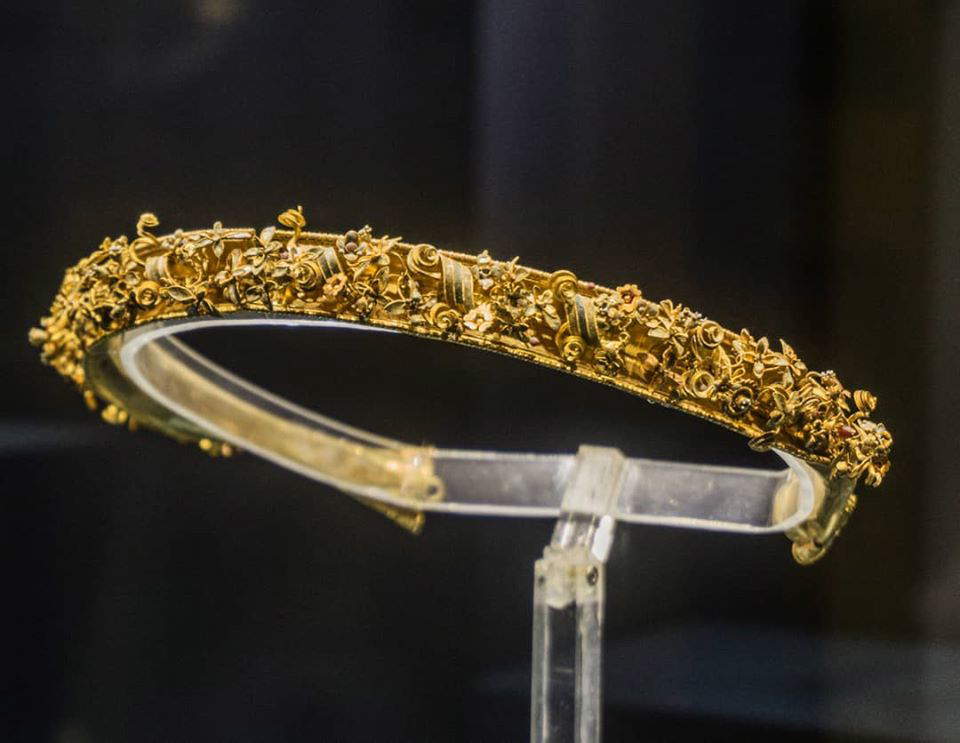 |
| Tarentine goldsmiths, Flowering diadem (late 3rd century B.C.; gold, pearls, enamel, glass paste and semiprecious stones, linear length 47.2 cm; Taranto, National Archaeological Museum). Ph. Credit Tommaso Saccone |
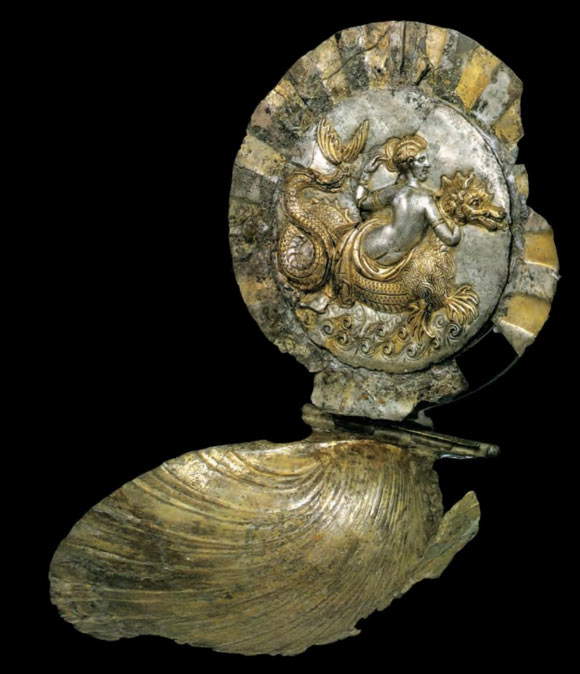 |
| Tarentine goldsmithing, Shell-shaped case (second half of 3rd century BC; silver and hot gilding; Taranto, National Archaeological Museum) |
 |
| Taranto goldsmith’s work, Oak-leaf crown (first half of 2nd century B.C.; gold; Taranto, National Archaeological Museum) |
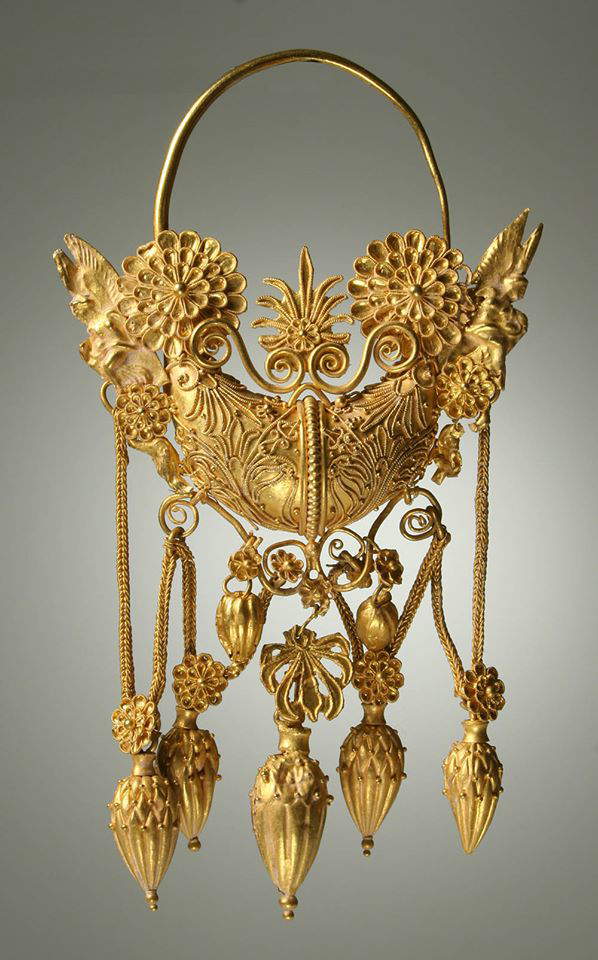 |
| Taranto goldwork, Shuttle earrings (4th century BC; gold; Taranto, National Archaeological Museum) |
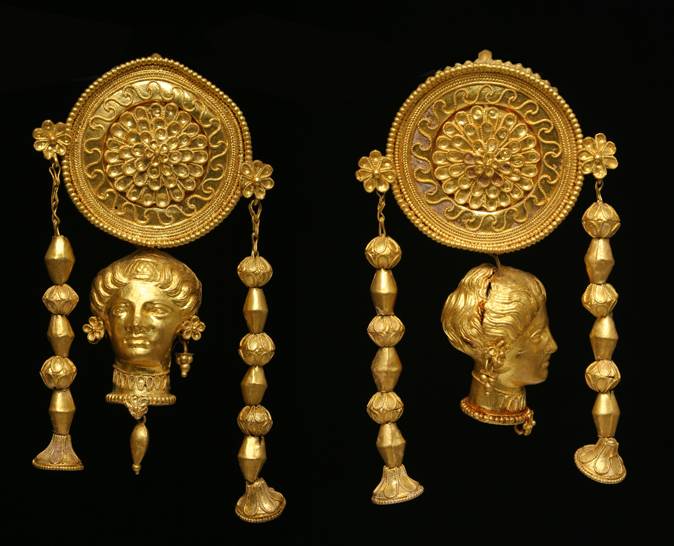 |
| Taranto goldwork, Disc earrings (mid-4th century B.C.; gold; Taranto, National Archaeological Museum) |
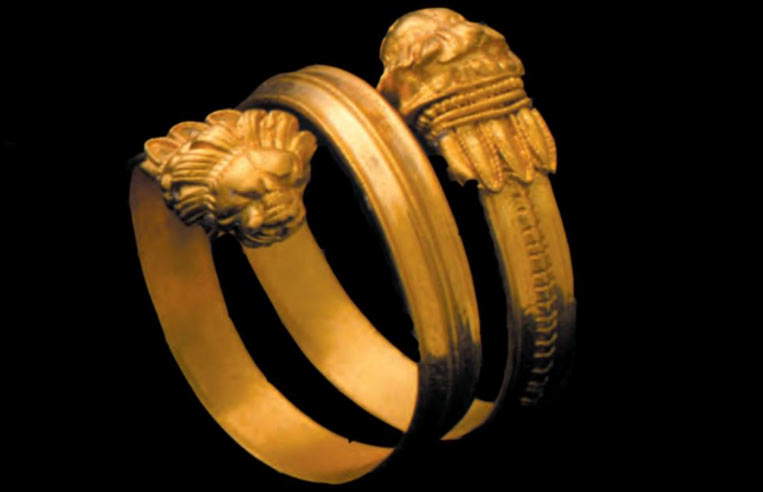 |
| Taranto goldwork, Ring (late 4th century B.C.; gold; Taranto, National Archaeological Museum) |
 |
| Taranto goldwork, Nutcracker (late 4th-early 3rd century BC; gold and bronze; Taranto, National Archaeological Museum) |
Most of the Taranto golds were found, as anticipated, in the 1920s, and their history is also punctuated by a particularly adventurous and dramatic episode, namely their journey to Parma during World War II: the Archaeological Superintendence of Taranto had in fact decided for their transfer to Emilia to avert the risk that they would be destroyed, dispersed, or stolen during the conflict (protective measures had already been put in place in Taranto, but the approach of the front line and the fact that Taranto was an important naval base used for wartime operations had suggested that the golds leave the city). They were therefore moved to two safe deposit boxes whose management was entrusted to the Parma branch of the Banca Commerciale Italiana, where there were some warehouses considered to be among the safest in Italy (in fact, they had been specially designed to withstand even aerial bombardment): accompanied by superintendence inspector Valerio Cianfarani, the golds arrived in Parma on February 2, 1943. The ori’s travails were not over, however, because as is well known, after September 8 Italy found itself divided, and while Taranto was still part of the Kingdom of Italy, Parma was instead under the Italian Social Republic: in December 1944, the Ministry of Education of the RSI requested the two boxes from the Bank (justifying the request on the pretext of moving them further north, to a safer location, since the front was approaching Parma), but the branch manager responded by stating that only Inspector Cianfarani would be able to regain possession of the boxes. The bank decided to stall, and the tug-of-war with the republican ministry went on for months, until April 25 arrived: the Republic of Salò had fallen, the golds were safe and could return to Taranto, in perfect condition. However, it would take another four years to see them on display again at the National Archaeological Museum, since the building had in the meantime been occupied by the Allies, who had turned it into a kind of warehouse, and it therefore needed to be restored.
The Taranto golds have been widely popular since the 1980s and have been displayed in exhibitions in various cities: of particular note is a traveling exhibition that took the golds to Milan, Paris, Tokyo and Hamburg between 1984 and 1986. Some 80 pieces from the collection last left Italy in 2010, when they flew to Shanghai, China, to be displayed at the Italian Pavilion of that year’s World Expo, in a goldsmithing exhibition that had seen them displayed alongside some contemporary jewelry creations. And indeed, even today the golds of Taranto continue to inspire artists and jewelers: it will be worth mentioning that in 2015, at the National Archaeological Museum in Taranto itself, the golds of Umberto Mastroianni, who was among the most prolific artists of the 20th century in the field of goldsmithing, were displayed alongside the museum’s Hellenistic golds. Their refinement, their elegance, their shapes that still surprise more than two thousand years later, their taste that meets the favor of many contemporary goldsmiths and designers have made them, after all, among the greatest goldsmithing masterpieces of all time, published not only in catalogs, books and scientific essays, but also in generalist, glamour or fashion magazines, known and appreciated all over the world, able to amaze even today those who observe them.
Warning: the translation into English of the original Italian article was created using automatic tools. We undertake to review all articles, but we do not guarantee the total absence of inaccuracies in the translation due to the program. You can find the original by clicking on the ITA button. If you find any mistake,please contact us.